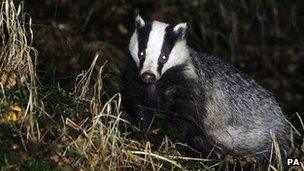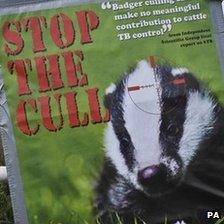How will the Gloucestershire badger cull turn out?
- Published
So as we get to the halfway point in the Gloucestershire badger cull people want to know how it is going.
The honest trust is that no one is revealing anything about how many badgers have been shot so far, or any assessment of the humaneness of the cull itself.
But I've been talking to plenty of people on all sides of the cull and looking at the few pieces of evidence that have emerged that might give a clue as to what is going on.

The badger culls started in August
One of the big issues with the cull is cost and that is why the decision was taken to use free-shooting to kill the badgers.
But from the start there were also plans to also use the more expensive cage-trapping and shooting method if needed. Money was even set aside to switch completely from one method to the other if the cull did not go as planned.
More cage-trapping?
Are we now seeing more cage-trapping than initially thought? Protestors have certainly filmed themselves destroying cages in the cull zone, although it is unclear if they were part of the cull or being used for vaccination instead. The more cage-trapping that has to be used, the more difficult the financial case for future badger culls.
But why might those behind the cull start using cage trapping at all? In terms of numbers each free-shooting marksman only has to kill a single badger a night to reach the target.
Given the large area the cull zone covers that does not seem too taxing. Despite strong anti-cull feelings the protestors just do not have enough people on the ground to disrupt the entire zone.
Badger DNA
But there is a second criteria to the cull. The numbers to be killed are based on a badger population survey.

Activists have vowed to continue their protest against the cull
The cull must remove 70% of the badgers which is around 2,900 animals. But researchers have also taken badger DNA samples and these will be compared to the DNA of all culled animals.
As well as reaching the grand total of animals to be killed, the cull also needs to remove 70% of the DNA profiled badgers.
Could that part of the cull might prove more difficult? Especially if the DNA sampled badgers live in an area that now has a heavy protestor presence?
A technical victory
So taking all that into account, I wonder if in three weeks time we will see the cull kill the number of badgers it needs to but fall short of killing the 70% of DNA profiled animals.
Both sides could technically claim victory but I think the farmers would win overall with this result.
Because what is really noticeable about this story is the lack of public outrage or even interest. So even if it is not a clear win for those on the side of further culls, the government may well roll them out anyway.
Which begs the even bigger question; what will the impact of this cull be on bovine TB in cattle? It will be a year or more before we can even start to answer that one.